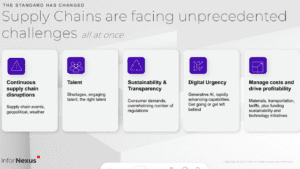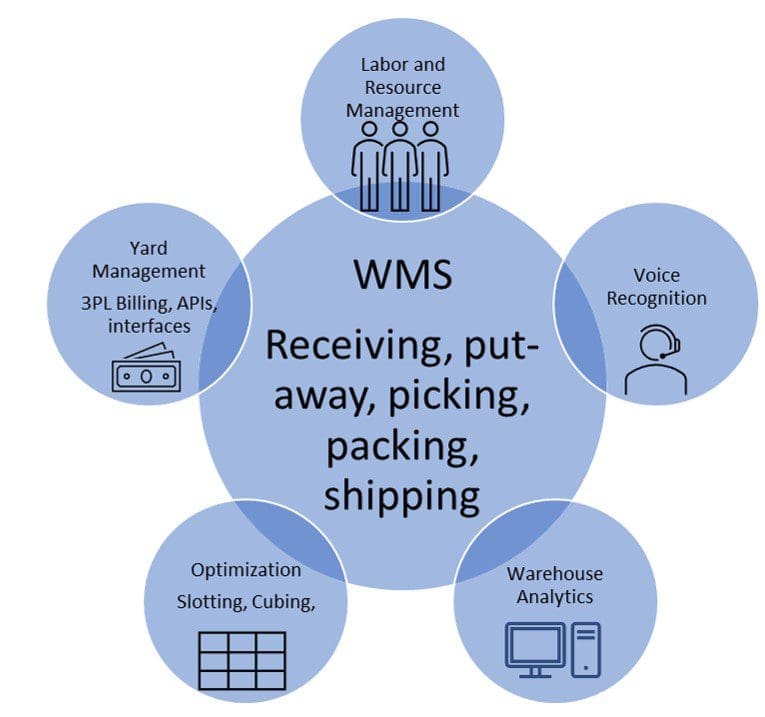A few weeks ago, I was fortunate enough to attend the Infor Analyst Innovation summit here in Manhattan, New York. This was an intimate, packed 2-day event with executives, customers, other market analysts, and additional Infor team members.
The event began with an address from the CEO, Kevin Samuelson, and CTO and President, Soma Somasundaram. Together, they presented the vision for the future and innovation priorities.

Thirty percent of digital transformation projects meet expectations. Infor calls this the “Value Void.” They are focusing on how Infor creates value through insights, automation, and process. They emphasized being an “Industry Cloud Complete Company with industry-specific solutions for over 2000 micro verticals across Process Manufacturing, Distribution, Service Industries, and Discrete Manufacturing. Below you can find the three Innovation Pillars they are focusing on within the next year and beyond.
Innovation Pillars:
- Diagnose: primarily powered by Infor Process Mining, this capability helps organizations gain visibility into business processes, uncover non-conforming variants, identify critical bottlenecks, and optimize operations based on data. Industry-specific content is available for processes like Source to Settle, Procure to Pay, Order to Cash, and more. A customer case story presented showed significant speed improvements in identifying process issues and reductions in employee time spent on this task, potentially leading to substantial annual savings through improved early payment discounts.
- Automate: utilizes technologies such as RPA, IDP, and IPaaS. RPA automates manual and repetitive tasks. IDP converts paper-based documents into automated digital processes. iPaaS provides a comprehensive set of tools for connecting applications. Examples of automatable processes include Invoice Processing, Sales Order Entry, and Customer Account Creation. A customer story highlighted saving thousands of hours annually and improving on-time delivery through automating part order processing.
- Optimize is driven by Infor AI, encompassing both Generative AI and Predictive/ Prescriptive AI. Predictive and prescriptive AI addresses use cases like inventory optimization, asset health predictions, yield optimization, and financial forecasting. Generative AI is being embedded into Infor CloudSuites and applications to generate content, summarize insights, and provide instant answers. Concepts like GenAI Assistants and Agents were presented, offering conversational interfaces and on-demand analysis. Specific AI use cases available in Infor WMS, such as Product Location Recommendations and the Facility Review Report (GenAI), were highlighted.

Overall, the executive-led sessions provided a comprehensive look at Infor’s strategy to deliver value through its industry-specific cloud platform and integrated advanced technologies. The strategy strongly focused on enabling customer success and accelerating innovation. The sessions covered the strategic vision, the underlying technology platform, the specific innovation tools, and the methodology for ensuring customers realize value.
Infor’s Enterprise Software Strategy:
Heidi Benko, VP of Product Management, presented the Infor Nexus portion of the summit, which identified key challenges they are aiming to solve, including continuous supply chain disruptions due to geopolitical tensions, climate-driven weather events, managing costs, and driving profitability amidst material, transportation, and tariff costs. The core message was that the standard for supply chains has changed, requiring a digital and intelligent network platform.
Innovation within Infor Nexus is focused on several key areas:
ESG & Traceability: With global regulations increasing transparency demands, Infor Nexus is innovating to help companies promote responsible sourcing, avoid penalties, provide evidence of chain of custody, and build consumer trust. Key features include Multi-tier Mapping and Trace Request. Innovations like NexTrace are being developed to support Digital Product Passports. The platform leverages AI and Digital Technologies like RFID at Source (reducing receiving and packing time and chargebacks) and 2D barcodes/Digital Links to drive transparency and capture data for product circularity.
Intelligence & AI Transformation: Recognizing that a significant portion of the data companies need resides outside their systems, Infor is embedding intelligence across the Nexus platform. This involves a Network Data Mesh for unlocking insights. Process Monitoring uses statistical models to identify delays, bottlenecks, and non-conforming processes with proactive alerts. Predictive Intelligence is being developed to use AI/ML to forecast completion dates for critical activities like Manufacture Complete, Carrier Pick Up, and Final Delivery. Features such as enhanced Detention & Demurrage (D&D) Management provide real-time visibility and alerts to help reduce costs. Smart Import is also being leveraged to accelerate data integration from various sources.
Generative AI (GenAI): GenAI is set to transform the user experience and augment the workforce. The upcoming (beta version June 2025) Infor Nexus Digital Assistant will offer a conversational interface allowing users to ask complex questions, get analysis, and access transaction links directly within the platform. The future direction includes Agentic AI, enabling specialized agents capable of autonomous or semi-autonomous tasks, with the ability to build custom agents for specific business processes. This aims to speed up access to data, enhance decision-making, automate tasks, and build trust in AI.

Day 2:
The second day included multiple breakout sessions focused on certain tools and industries of focus. As I am currently completing ARC’s 2025 Market Analysis for Warehouse Management Systems, I was very keen to hear what Infor had to present on this topic.
Warehouse Management Systems:
This session highlighted Infor’s unique advantages in Warehouse Management, emphasizing its cloud-native architecture, comprehensive unified solution, and how it leverages the Infor Industry Cloud Platform for capabilities like extensibility, document management, analytics, and workflows.
Much of the conversation focused on accelerating innovation via a robust WMS roadmap, particularly concentrating on AI-infused innovation encompassing Machine Learning, Predictive Analytics, RPA, and Generative AI.

Specific innovations presented included embedded GenAI use cases and the GenAI assistant, predictive intelligence for tasks such as product volume forecasting and anomaly detection, automation examples utilizing IDP and RPA, and industry solutions like counter sales and a self-service portal. Most of the conversations over the two days highlighted Infor’s Gen AI assistant capabilities.
Their WMS solution has been clouding native for 5 years and includes labor management within its scope. Additionally, I asked about the impact of automation on the warehouse floor. Their response, “Automation will be a major help in making up for the large labor gap, which is only growing. In terms of the solution, whether it’s a human or robot, it is still a resource that needs to be optimized for maximum effectiveness.”
The session also featured the significant momentum of Infor WMS, evidenced by cloud customer growth and uptime, reiterating the commitment to achieving positive customer outcomes, improving efficiency, and optimizing warehouse operations.
Closing Thoughts:
The Infor Analyst Innovation Summit highlighted Infor’s strategy as the “Industry Cloud Complete Company,” emphasizing accelerated innovation across its solutions. Infor’s strategy is clear. They are investing in micro-verticals, tailoring solutions by understanding their customers’ needs, and investing in innovative technology to execute with a tight focus. Infor is leveraging its Industry Cloud Platform and advanced technologies, including AI, Generative AI, Process Mining, and RPA, to provide its customers with industry-specific solutions. Overall, the discussions and customer case stories showcased Infor’s innovations, which are designed to deliver predictable results and simplify the path to value realization for its customers.

















 Note: Today’s post is part of our “
Note: Today’s post is part of our “
 Note: Today’s post is part of our “
Note: Today’s post is part of our “